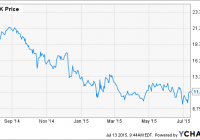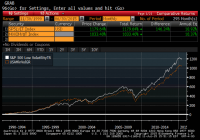General Electric’s Asset Sales Are Creating A Natural Gas Buy With A Dividend
Summary Black Hills Corporation has announced the acquisition of SourceGas Holdings LLC from GE/Alinda Capital. The Acquisition is a continuation of GE’s selloff of assets in a broader strategy to streamline the firm. Black Hills expects the purchase to increase their customer base by 55%. That kind of increase in business is going to have real effects on their earnings per share. What’s Going On? I have written previously about General Electric’s (NYSE: GE ) continued exit from the Finance industry. Most recently, Black Hills Corporation (NYSE: BKH ) has announced its acquisition of SourceGas Holdings LLC. SourceGas is managed by GE energy Financial Services and Alinda Capital Partners. SourceGas has 4 utilities in the United States that serve over 400,000 customers in the western United States. It also has a 512-mile intrastate natural gas pipeline that operates in Colorado. SourceGas was created in 2007 when GE and Alinda Capital made a purchase from Kinder Morgan Inc. (NYSE: KMI ). What’s So Good About It? The $1.8 billion deal is a continuation of General Electric streamlining its business. I am a continued advocate that a streamlined General Electric focusing on its core strengths is going to be a great business to own. The firm will be much better situated to react to economic changes in a timely manner. This acquisition also brings a whole new investment into play. It is a sweet deal for Black Hills Corporation. The firm is no slouch to begin with. The past three years have seen growing net income, improving balance sheets, and improved cash flows. The SourceGas Holdings purchase will increase Black Hills’ customer base by 55% . The company has noted that the effective purchase price will actually be lower due to tax benefits incurred by the acquisition. This is a continuation of the progressive integration of 19 utility systems in the last 10 years. President and CEO David R. Emery spoke strongly about the acquisition strengthening the growth of Black Hills. “SourceGas is a great strategic fit, adding to our strong utility base and providing operational and financial benefits to all the customers and communities we serve. We are excited to significantly expand our presence in Colorado, Nebraska, and Wyoming, and look forward to serving customers and developing new relationships in Arkansas. The transaction continues our proven record of growth in the utility business through targeted acquisitions — over the last decade, we have successfully integrated 19 electric and natural gas systems in support of this growth strategy.” For a utility firm like Black Hills, the importance of natural gas purchases cannot be stressed enough. Natural Gas officially surpassed coal this week as the largest US electric source. The move to buy SourceGas is part of a bigger strategy for the firm to diversify its power sales due to declining wholesale volumes . Stacy Numeroff (an analyst at Bloomberg) noted that “gas utilities do not face the same threats to load growth from distributed generation as their electric counterparts.” It is very encouraging that the utility firm is working to get in on the better growth offered in gas utilities. It is also worth noting that while Black Hills has experienced declines in power sales over the past few years, their net income has increased every year since 2011 demonstrating management’s ability to react to market moves. The one concerning thing about Black Hills’ acquisition is the $720 million that will be added to their current $1.2 billion in debt. The 55% increase in their customer base seems positive enough to let this debt be acceptable, but it is still a concern. As of now, the deal is expected to be completed in early 2016. Mark Maloney (a manager at Manulife Asset Management LLC) pointed out that “Black Hills has a strong track record of accumulating small utilities over the years and they’ve been very successful.” Do You Invest? In the last seven quarters , Black Hills has had 5 earnings beats, with one miss. The question is whether or not the acquisition of SourceGas is going to have a positive effect on earnings per share. The company has stated that it will add “meaningfully” to earnings. With the SourceGas deal increasing its customer base by more than half, I don’t see how it can’t have awesome outcomes for earnings per share. It’s worth noting that 1-year earnings per share growth is already ahead of its 5-year growth rate. The P/E is right along with the Multiline Utilities average, so Black Hills is not costing you any premiums. The 1-year price target of $55.50 seems obtainable if this deal plays out. If you can stomach the debt situation, good net income, improving balance sheets and cash flows on top of the growth potential from this acquisition make for a nice future play with a 3.5% yield cherry on top. Disclosure: I/we have no positions in any stocks mentioned, and no plans to initiate any positions within the next 72 hours. (More…) I wrote this article myself, and it expresses my own opinions. I am not receiving compensation for it (other than from Seeking Alpha). I have no business relationship with any company whose stock is mentioned in this article.

